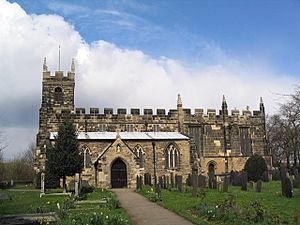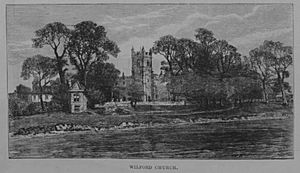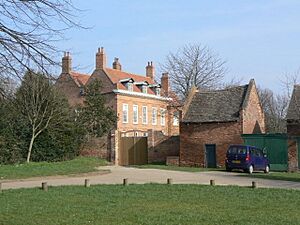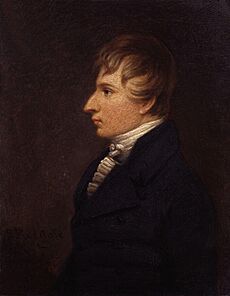St Wilfrid's Church, Wilford facts for kids
Quick facts for kids St Wilfrid's Church, Wilford |
|
|---|---|

St Wilfrid's Church, Wilford
|
|
| 52°56′5.29″N 1°9′32.57″W / 52.9348028°N 1.1590472°W | |
| Location | Wilford |
| Country | England |
| Denomination | Church of England |
| Website | wilford.org/church/ |
| History | |
| Dedication | St Wilfrid |
| Architecture | |
| Heritage designation | Grade II* listed |
| Administration | |
| Parish | Wilford |
| Deanery | West Bingham |
| Archdeaconry | Nottingham |
| Diocese | Diocese of Southwell and Nottingham |
St Wilfrid's Church in Wilford is a very old and important church in Nottinghamshire, England. It's part of the Church of England and is recognized as a special historical building. This means it has a Grade II* listed status, showing its importance.
Contents
History of the Church
This church was built a long time ago, starting in the late 1300s. People believe a person named Gervase de Wilford began its construction around 1361. The main entrance, called the porch, and the central part of the church, known as the nave, are from the original building. The tower and the chancel (the area around the altar) were added in the 1400s.
The churchyard has graves that are even older, from the 1300s. Some parts of the walls inside the church might even be from a church that stood here before the Norman Conquest in 1066.
The church was built using many different types of stone from nearby areas. These stones came from places like Gedling and Bulwell. Over time, the church's stone became dirty from a power station that used to be across the river.
You can find old sundials, called Mass Clocks, etched into the stone. These were used long ago to tell time for church services. There's also a unique carving on the roof that looks like a pig, which is thought to be over 900 years old. The roof of the nave was replaced in 1935, and the chancel roof in 1960.
War Graves and Captain John Deane
The churchyard is also a resting place for soldiers. It contains graves of eight soldiers from World War I and an airman from World War II. These graves are cared for by the Commonwealth War Graves Commission.
Another interesting grave belongs to Captain John Deane. He was an adventurer who lived in the village. In 1710, his ship, The Nottingham Galley, sank off the coast of New England. Captain Deane and his crew were stuck on an island. They faced extreme hardship before being rescued. Later, Deane served in the Russian navy under Peter the Great. He returned to Wilford in 1736. His tomb and its railings are also protected as a Grade II listed structure.
The Gazebo
In the churchyard, there is a small, elegant building called a gazebo. Henry Tull built it in 1757 as a summer house for people attending the church. It was damaged by a fire in 1976 but was restored in 1980. The original roof survived the fire.
Because the gazebo is next to the River Trent, its basement was once used as a place to keep bodies before burial, known as a mortuary. In the 1700s and 1800s, important meetings about deaths, called Coroner's Inquests, were often held in church porches. Since there was a ferry and difficult river crossings nearby, these meetings were common at Wilford. This made the mortuary a necessary part of the church grounds. The gazebo is also a Grade II listed building.
Benjamin Carter's Legacy
Benjamin Carter was the Rector (a type of priest) of St Wilfrid's from 1694 to 1732. He was a very generous person who helped the local community a lot.
He provided money to build the current church school, now known as South Wilford CofE Primary School. He also built the rectory (the priest's house) around 1720, along with its barn, stables, and a dovecot (a building for doves). He left money for many other good causes too.
Today, a charity called Carters Educational Foundation continues his work. This foundation uses the money Carter left to support the South Wilford Endowed Church of England Primary School. It also helps young people in Wilford with their education and personal development through grants.
Benjamin Carter was also a chaplain to the Duke of Devonshire. He held other church positions and became a canon of Southwell Minster in 1705.
In 1717, he gave special silver plates and cups, called Communion Plate, to the church. Some of these are still used today.
The old rectory was sold in the 1990s, and a new one was built nearby. The church grounds still include the dovecot and other buildings Carter had built. There are also two halls named after him: the Church Hall and the Benjamin Carter Hall.
Carter passed away in 1732 and was buried in the church, but his grave is not marked with a stone.
Henry Kirke White, the Poet
The famous poet Henry Kirke White lived in Wilford between 1804 and 1805. He found inspiration for many of his poems from the beautiful area around Wilford. He often wrote his poems in the gazebo located in the church grounds. Here is a small part of a poem he wrote about the area:
Here would I wish to sleep, this is the spot
Which I have long marked out to lay my bones in.
Tired out and wearied with the riotous world,
Beneath this yew would I be sepulchred.
Kirke White died at the young age of 21 while studying at St John's College, Cambridge. He was buried in a church in Cambridge. St Wilfrid's Church has two special memorials to him: a marble plaque inside the church and a beautiful stained glass window from around 1870.
Church Organ
The church's organ was built in 1878 by a company called Henry Willis. You can find more details about this organ on the National Pipe Organ Register.
See also
- Grade II* listed buildings in Nottinghamshire
- Listed buildings in Nottingham (Clifton North ward)




